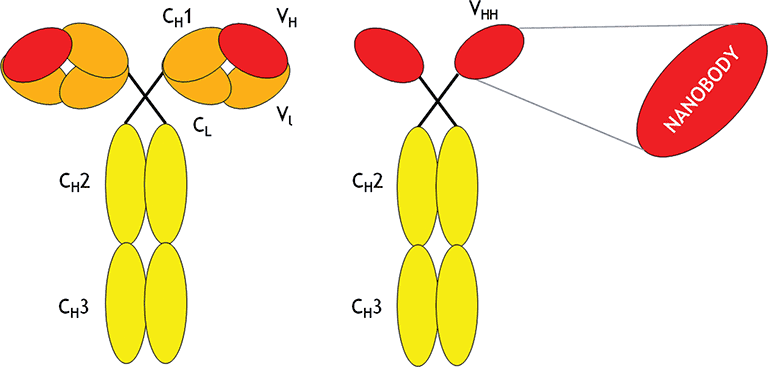Creative Biolabs possesses unchallenged experience in bispecific sdAb (bi-sdAb) synthesis. Multiple platforms of Creative Biolabs are elaborately integrated for providing customers an expected bi-sdAb with high affinity and low immunogenicity for both academic and industrial purposes.
sdAb
Recently, 'Heavy-chain only' antibodies have been found in the blood of camelids. According to their size (about 15 kDa), the antigen-binding fragments (VHH) of 'Heavy-chain only' antibodies containing a unique Ig fold are called sdAbs. The VHH sequence shares a high degree of identity with human VH and enables to be further “humanized” to prevent a human anti-camel antibody response. It comprises several hydrophobic to hydrophilic hallmark amino acid substitutions in its framework-2 region which make the recombinant domain monomeric, more soluble, and well expressed in bacterial systems. Besides, particularly appealing point of sdAb is that they have the capacity to simultaneously inhibit diverse important growth factor receptors or their ligands with a single molecule. Moreover, they are easy to be cloned and expressed on the tip of filamentous phage, which allows the selection of sdAbs inducing particular biological effects. They have potential to be essential cancer therapeutics in the near future, exhibiting unequalled and unprecedented efficacies in treatment.

Fig. 1 Schematic representation of a conventional antibody, heavy‐chain antibody and a sdAb.1
Bispecific sdAb (Bi-sdAb)
Creative Biolabs has developed various bi-sdAbs based on recombinant sdAbs. Due to the small size of sdAbs, which closely matches the size of the scorpion toxic polypeptides (7 kDa), the sdAbs are expected to diffuse equally well throughout the body and tissues to reach and neutralize the toxin. Thus, their small size and their strict monomeric behavior make sdAbs ideal for assembly in a bispecific construct. Bi-sdAbs are easy to generate in Escherichia coli, very stable, and lead to potent lysis of tumor cells by human natural killer cells at picomolar concentrations. Different from common antibodies, they do not engage inhibitory FcgRIIb receptor, do not compete with serum immunoglobulins G for receptor binding, and their cytotoxic activity is independent of Fc glycosylation and FcgRIIIa polymorphism. The advanced sdAb technology platform enables rapid formation and large-scale production of novel Bi-sdAbies which have potential in a number of human diseases.
With the well-established bi-sdAb generation platform, the experienced scientists here at Creative Biolabs are dedicated to help you develop unique Bi-sdAb. We also provide other various services regarding BsAbs development. Please feel free to contact us for more information and a detailed quote.
Reference
1. Verhelle, Adriaan, and Jan Gettemans. A Nanobody-Based Approach to Amyloid Diseases, the Gelsolin Case Study. IntechOpen, 2016. Distributed under open access license CC BY 3.0, without modification.
Our products and services are for research use only, and not for use in diagnostic or therapeutic procedures.
Welcome! For price inquiries, we will get back to you as soon as possible.
To order, please email
INQUIRY








